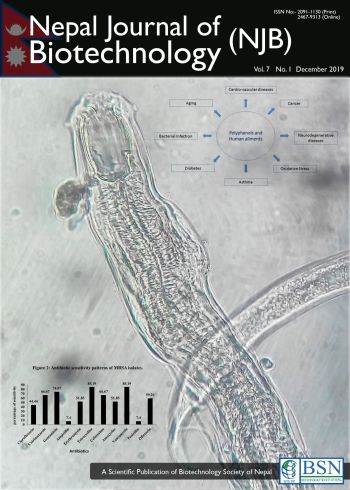Phenotypic characterization of beta-lactamases producing Gram-negative bacteria in a tertiary hospital, Nepal
DOI:
https://doi.org/10.3126/njb.v7i1.26954Keywords:
Antibacterial resistance, extended-spectrum beta-lactamases, ESBL, Gram-negative, metallo-beta-lactamase, MBLAbstract
Infections caused by beta-lactamases producing Gram-negative bacteria are increasing, thus posing a challenge to the management of such infections. The surveillance data of such bacteria is limited in Nepal so this study aimed to detect the beta-lactamase producing Gram-negative bacteria in a tertiary setting. A total of 604 clinical samples, including urine, blood, sputum and body fluids, were cultured and identified by the routine standard laboratory protocols. Antibiotic susceptibility testing was done by Kirby Bauer disc diffusion method following Clinical and Laboratory Standard Institute guidelines (2014). Extended-spectrum beta-lactamases (ESBL) producers were identified by combined disk method and metallo-beta-lactamases (MBL) producers were identified by Imipenem- EDTA combined disk method. Out of 604 samples, 282 (46.7%) samples showed significant growth, of which 229 (81.2%) were Gram-negative bacteria. Of 229 Gram-negative bacteria, 200 (87.3%) were multidrug resistant, 67 (29.3%) were ESBL producers and 16 (7.0%) were MBL producers. Klebsiella pneumoniae were among higher ESBL producers and Pseudomonas aeruginosa were among higher MBL producers. The findings suggest higher antibacterial resistance among Gram-negative bacteria with the added burden of beta-lactamase production. Imipenem was effective against 125 of 229 Gram-negative bacteria tested. Thus, imipenem can be the drug of choice for empirical management. The higher multidrug resistance and higher beta-lactamases production among Gram-negative bacteria warrant the continuous monitoring, surveillance, early detection, and infection control practices of such bacteria
Downloads
Downloads
Published
How to Cite
Issue
Section
License
Copyright Notice:
The manuscript submitted to NJB must be an original contribution, not previously published and should not be under consideration for publication elsewhere. When the manuscript is accepted for publication, the authors agree to automatically transfer the copyright of the article to the publisher. It should grant permission to any third party, in advance and in perpetuity, the right to use, reproduce or disseminate your article, according to the NJB copyright and license agreement.
Authors transfer copyright to the publisher as part of a journal publishing agreement but have the rights to: Share their article for Personal Use, Internal Institutional Use and Scholarly Sharing purposes, with the NJB applies the Creative Commons Attribution-NonCommercial CC BY-NC license to all the works we publish after Jun 2020 (Before it was CC BY-NC-ND). Under this license, authors agree to make articles legally available for reuse, without permission or fees, for virtually any non-commercial purpose. Anyone may remix, adapt, and build upon your work non-commercially, and although their new works must also acknowledge you and be non-commercial, they don’t have to license their derivative works on the same terms. More details on CC BY-NC refer to its Licence Deed and Legal Code.






